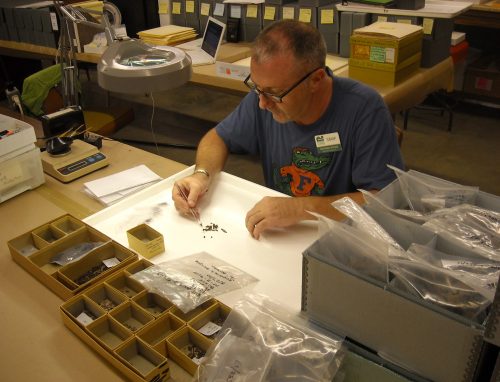Analysis of the BCM5 material excavated in 2009-2010 is underway. The Brown’s Mound Complex is seen by visitors adjacent to the teaching pavilion at the Calusa Heritage Trail, and includes the often-climbed, nearly 30-feet-tall Brown’s Complex Mound 1 (BCM1).

The truncated BCM5 is located between BCM1 and Waterfront Drive. We were able to get two radiocarbon dates from Operation M-3 using fighting conch (Strombus alatus) shells from the 50-x-50-cm zooarchaeological sample. Level 91, which is from 80 to 90 centimeters below datum, dated to about A.D. 650. Level 96, from 130 to 140 centimeters below datum, dated to about A.D. 440. Level 96 is at the current intertidal zone, as deep as we can dig without pumping out water. The two dates are in stratigraphic and temporal sequence, which suggests that the mound is mostly undisturbed under a layer of historic debris.
Analysis of animal bones and shells is nearly complete, and will help us correlate the environmental information from Mound 5 with other contemporary units at Pineland. The two dates bracket the beginning of the Vandal Minimum (ca. A.D. 550), when global climate was in flux. A close analysis of the animal bones and shells could show how these global events affected Pine Island Sound and its residents at this time. It was very helpful to be able to use the comparative faunal collections at the Ruby Gill House lab this summer to continue working on the collection while at Pineland. Also, thanks to UF undergrad Jason Breslin of Naples for his help in the initial faunal analysis.
Illustrator Sue Ellen Hunter is working on professional renderings of the profiles and notable artifacts from the excavation. Readers will be familiar with Sue Ellen’s work from the many publications she has assisted with at he Pineland Site.
If all goes well, the excavation report will be completed next spring, and another piece of the Pineland puzzle will fit into place. Many thanks to Drs. Marquardt and Walker for their assistance in this project, and to all the RRC volunteers who were kind enough to participate in the Mound 5 dig.
This article was taken from the Friends of the Randell Research Center Newsletter Vol 10, No. 3. September 2011.